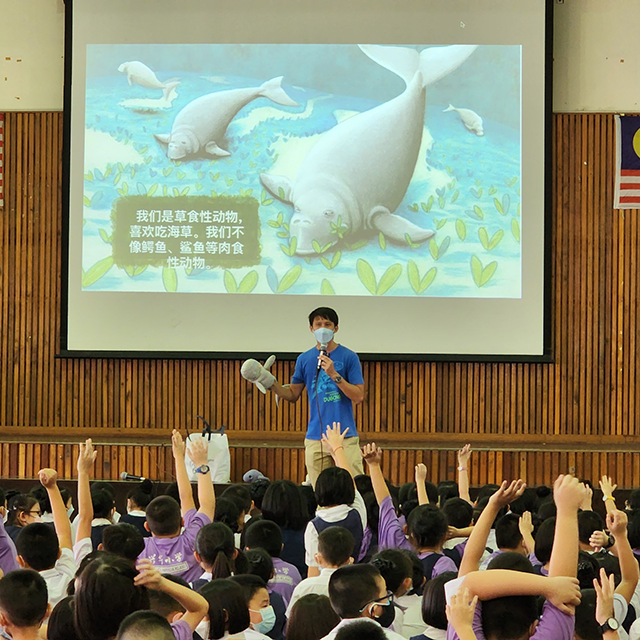Harris Heng Wei Khang, a CBCS PhD candidate supervised by Associate Professor Daniel Dunn, Professor Peter Mumby and Dr Janet Lanyon, has recently been awarded a grant from the National Geographic Society in support of his research project, “Dugong Connectivity in Southeast Peninsular Malaysia: Innovative Approaches for Challenging Habitats” as a National Geographic Explorer.
As a National Geographic Explorer, Harris becomes part of a community of likeminded individuals who share a passion for exploration and discovery, and address critical environmental issues with projects that have the potential to generate significant impact.

Photo credit: Research team of Dugong Underwater Monitoring Project – Malaysia
Dugongs in the meadow
The journey to the award began with Harris investigating the spatial feeding ecology of Endangered dugongs in their seagrass habitats at the Sibu-Tinggi Archipelago in southeast Peninsular Malaysia. Harris faced the task of studying this elusive species in their seagrass meadow foraging habitats, which in Malaysia are challenging to study due to high water turbidity levels and complex subtidal geo-ecological systems. Recognising this challenge, Harris and his team from the Team Sea Habitats (a spatial ecology lab at Universiti Malaya, Malaysia) and The MareCet Research Organization (a marine mammal-focused NGO) took a different approach – tracing the feeding trails of dugongs in the meadow – to know what and where the animals feed. The result? They mapped the largest single subtidal seagrass meadow in Peninsular Malaysia (~13 km2), revealing distinct spatial feeding patterns driven by seagrass cover (Heng et al. 2022).
While this initial study laid the foundation and provided vital information for delineating protected areas for dugong feeding, there remained a dearth of long-term data on dugong populations, spatiotemporal habitat utilisation patterns, and the dynamic relationship between segrass and dugong. This knowledge gap limits our understanding of how populations may be affected by various disturbances under environmental change. As the direct observation, capture and tagging of animals have been a challenge in seagrass habitats in Malaysia, Harris realised the need for a transformative and strategic approach to continuous data collection.
Data collection with eDNA and UAVs
Through this National Geographic award, Harris aims to integrate environmental DNA (eDNA) and unmanned aerial vehicle (UAV) surveys to overcome barriers in obtaining long-term species’ population information in five ways:
- enhancing access to new data collection of the animals without relying on direct sightings;
- reducing the cost and risk linked to traditional field methods;
- offering a non-invasive solution applicable to other marine taxa, particularly elusive species;
- leveraging the advantages of both eDNA and UAV approaches to complement each other’s limitations; and
- being adaptable for partial or full implementation by local communities.
This integrated approach is envisioned to serve as a biomonitoring tool for conserving dugongs in remote and challenging environments.

Photo credit: Ong Wan Ning
Joining a global community
With the support of the National Geographic Society, Harris will join the global community of National Geographic Explorers to make significant positive contributions to their fields. He won’t just look at the world from the ocean and/or the sky (i.e., using eDNA and drones), he will also share the stories and discoveries of dugong and seagrass with the public, continuing his effort in community outreach and educational activities in Malaysia.
“I’m thankful to everyone who has encouraged me to continue in conserving oceans despite the lack of attention and resources available to undertake conservation research in Malaysia.” Harris said.
“I have been creating little ripples since I started. Now I can equip myself to make a bigger impact, fostering a greater understanding and conservation of the natural world.”

Photo credit: Nina Ho
Read more of these stories in Issue 16 of the CBCS Newsletter and follow us on X (Twitter) and LinkedIn.

